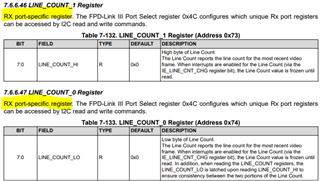Hello, Team,
Our customer would like to check for both 960 and 953 capability on how to check a video size (height and width) using a register.
What they want to do is to check whether the video image does not exceed the default setting, or monitor the video image size (height and width).
It seems that by using LINE_LEN_MISMATCH, we can monitor width; is this correct?:

The way to check the size could be either actual received size or just a packet header.
Best Regards,
Masaru




